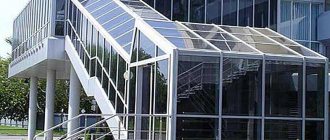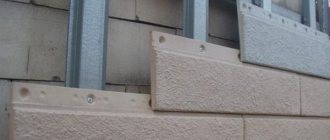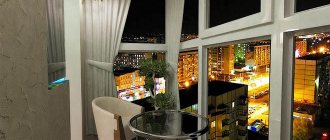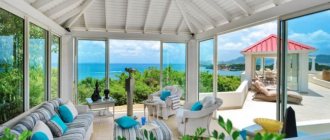home
> Glazing of facades
> Strip glazing
Advantages Examples Calculation Application Our work Bonuses Prices Guarantees
Calculate the project
Construction carries out strip glazing of objects of any size and any configuration, using advanced technologies and materials.
What is "strip glazing"
Strip glazing is a facade structure in the form of a continuous row of windows without partitions or in the form of a glass strip in which individual translucent elements are located horizontally and sequentially on the facade, without visual separation. Such glazing can be performed floor by floor, when the glazed floor alternates with a regular floor, along one side of the building or along its entire perimeter. The load-bearing structure of the system can be attached to the plane of the external walls, as well as to the ends of the floor slabs, to the window sill walls, or in any other appropriate way arising from the architectural and design features of the building.
What kind of technology is this
Strip glazing is separate window blocks that are connected to each other in a row. Typically, such blocks are installed either in a horizontal plane or in a vertical direction. Most often, this type of glazing is considered optimal for the improvement of industrial workshops, office or commercial buildings, as well as entertainment and shopping centers. For this reason, aluminum and plastic are used in the production of double-glazed windows, because it ensures the strength and reliability of strip glazing. Technologies are called strip technologies for the reason that the glazing of the room occurs with a strip (conventional name), in a row (a more correct, professional name).
The installation method occurs by connecting plastic or metal-plastic profiles to each other. Including combining balcony doors, both folding (hinged) and sliding. Due to such glazing, which covers most of the area of the load-bearing walls, daylight completely penetrates into the room, which ensures savings in energy spent on additional lighting. The doors can be either stationary or mobile, movable. The latter option allows you to ventilate the room in time or go out onto the balcony or terrace.
Strip glazing: warm or cold?
Aluminum profile frames, which are used for strip glazing of facades, are divided into two main types: “cold” and “warm” (thermal insulated). “Warm” profiles are traditionally used for glazing construction sites with internal heating to prevent heat loss. The “cold” profile is installed in buildings with unheated rooms, and is also used for glazing balconies, loggias, and terraces. The type of profile corresponds to the type of glass elements installed in them. In “cold” glazing, single tempered glass is used, and in “warm” glazing, double-glazed windows are used, which the customer can choose according to his taste: with energy-saving glass, with UV filters, and others.
Double-glazed windows for strip structures
All openings with a large glazing area have one serious problem - high heat loss. Due to the peculiarities of strip window structures, the main leakage occurs through the glazing, as a result of which special attention must be paid to this area. The correct choice of double-glazed windows will reduce heat loss and maintain a comfortable temperature in the interior during the autumn-winter period. Currently there are three main options:
- Standard double-glazed windows with inert gas - this option was in demand earlier, but with the advent of new technologies it has lost popularity. The main problem of double-glazed windows for light openings with a large area is a significant increase in weight. As a result, the load on supporting structures and fittings increases, which ultimately negatively affects the reliability of such structures.
- Energy-efficient single-chamber double-glazed windows with selective coating - in terms of heat saving, they are 10-20% superior to double-chamber models, and weigh 40% less. Injecting inert gas can increase the efficiency of these double-glazed windows by another 10%, so they are perfect for use in regions of Russia with a temperate and warm climate.
- Double-glazed windows with electrical heating retain heat best, but are more expensive than the two previous modifications. Thanks to their use over a large glazing area, it is possible to reduce heat loss even in severe frosts. These products are best suited for areas with harsh climate conditions.
For objects whose glazed openings face the sunny side, not only the issue of heat conservation, but also excessive insolation is relevant. This problem is easily solved by installing multifunctional double-glazed windows that retain heat inside the rooms and protect the premises from overheating by the sun's rays.
When installing strip glazing based on structures made of PVC profiles, it is necessary to take into account that double-glazed windows can only experience wind loads during operation. There should be no other impacts on these elements.
Selecting a profile strip glazing system
For strip glazing, we use a wide range of facade systems, helping the customer choose for their building the type of structure that is optimal for them in terms of price, aesthetics and functionality. The following systems can be used for strip glazing:
- Post-transom system
- Spider system
- Frame glazing system
The choice of system depends on the architectural features of the facade, the purpose of the building, the height of the glazed openings, the complexity of installation, the number of floors and a number of other factors.
Do you have any questions about strip glazing of the facade?
Leave a request on the website, and our specialists will advise you on your project and the choice of a strip glazing system.
To get a consultation
Specifics of mullion-transom glazing design
The mullion-transom system (MCS) for glazing the façade of buildings for various purposes is a structure made of vertical and horizontal metal profiles. The post-transom frame consists of racks on which horizontal beams - crossbars - are installed.
Photo: 66.RU from partners
CPC glazing is used to increase the transmission of natural light through structures. Application area:
- stained glass;
- glass roofs;
- verandas and terraces;
- winter gardens;
- loggias and balconies of residential buildings;
- window structures of office buildings.
The load-bearing capacity of the structure directly determines the choice of material and their properties. Thermal conductivity in SRS increases or decreases due to the profile chambers and the technical characteristics of the thermal insulation.
Advantages of SRS:
- saving electricity due to the entry of a large amount of natural light;
- window tightness;
- reliability, durability;
- the ability to make structures of any shape;
- fire safety;
- environmentally friendly materials;
- used for glazing the facades of large buildings;
- convenient installation;
- variability of designs.
Installation of strip glazing
Installation of strip glazing is carried out by experienced installers using professional equipment, special equipment and equipment. Many years of experience and the responsibility of our craftsmen, as well as the use of advanced technologies and the best materials, allow us to implement the most complex projects with consistently impeccable quality. We provide a 7-year guarantee for all types of work.
Following a client-oriented policy, we do everything possible to reduce client costs to a minimum.
Structural and semi-structural glazing
Structural glazing can be used for both new and old buildings. During the installation process, the glass units are fastened to the load-bearing elements using sealant, as a result of which the building takes on the appearance of a solid glass wall. Such strip glazing without pillars helps protect the façade from external influences and has excellent resistance to dynamic loads.
Semi-structural glazing involves fastening the glass unit around the entire perimeter or on both sides with special strips. This type of glazing is used relatively less frequently, as it is highly expensive.
Prices for strip glazing of facades
This type of glazing of buildings is a structure of windows adjacent to one another, without delimiting spaces, and which are formed into extended strips. produces strip glazing of facades in high-rise buildings at manufacturer's prices using aluminum profiles.
| Name | Unit. | Price |
| With decorative overlays, classic | per m2 | from 12,500 rub. |
| With decorative overlays, classic with opening | per m2 | from 13,700 rub. |
Where is it used, and what types of double-glazed windows are used?
Glazing technologies using translucent materials for house facades are proving very interesting. Designs can be small, standard, or large-sized. In order for them to withstand the weight of the building, builders use strictly metal-plastic or aluminum warm profiles that can withstand a lot of weight. Facades are glazed using the strip method most often in the following cases:
- store display areas;
- shopping centers;
- banks, large financial and credit or business centers;
- sports complexes;
- industrial buildings;
- social and public buildings of modern architecture.
In a short time, using aluminum profiles, you can build window structures of almost any configuration. Residential buildings can be glazed with a strip version in multi-apartment high-rises, where there are wide loggias and terraces. In private houses, small elements of strip glazing are used, which give the buildings a stylish and modern look.
Glazing of industrial buildings according to GOST
Throughout Russia, strip glazing of industrial buildings is regulated by GOST. Certain standards are written down on several pages.
GOST specifies permissible types of structures, sizes of window units, fittings, glass specifications, marking methods, as well as features of the junction of strip glazing units and other parameters.
To clarify all the details of such glazing, it is best to carefully read the document or entrust the choice of technology to professionals.
Advantages of strip windows
Depending on wishes and capabilities, laminated, tempered or reinforced glass with different protection classes is used:
- class “A” (resistance to accidental impacts);
- class “B” (burglary protection, high-strength bulletproof).
Residents of megacities, especially in northern latitudes, are in dire need of sunlight, for example:
- in supermarkets with strip facades, the greatest purchasing activity is observed;
- in office buildings, the highest labor productivity;
- in hospitals, patients recover faster, etc.
Price
Strip glazing is considered the most common type in the construction and repair of industrial buildings and structures. The cost of work consists of the volume, type of structural and consumable elements used, the height of the building and the profile used.
To find out in advance the cost of glazing an industrial building, you should contact a company that is professionally involved in this area. They will be able to advise at a high level and carry out all the necessary calculations, as well as draw up design documentation and subsequently carry out strip glazing.
Which industrial buildings use strip glazing?
Companies involved in such glazing of buildings and structures carry out both standard and non-standard projects. Glazing is carried out in factories and factories for absolutely any purpose. These can be chemical production facilities, warehouses, terminals, boiler houses, food and light industry enterprises, as well as conveyor shops and product processing areas.
Strip glazing will give any building a respectable appearance and make it durable, airtight and fireproof. The glazing technology completely depends on the approved project and is agreed upon with the customer.











